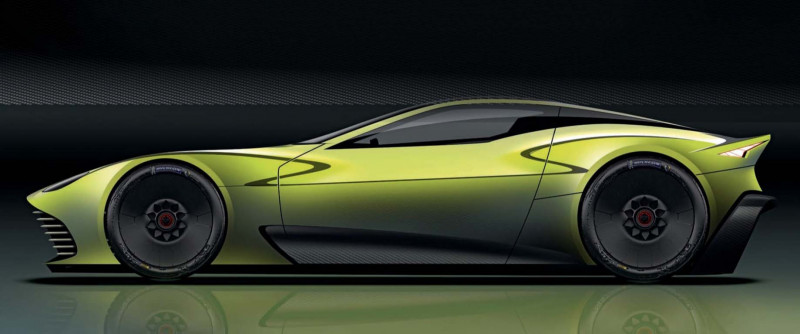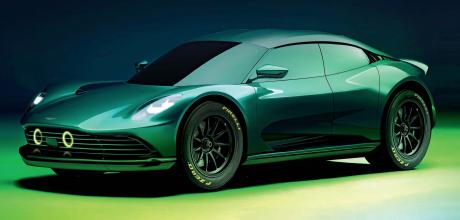Aston Martin EVs SUV and GT with Lucid, Geely help
Aston’s EVs to pack Lucid tech starting with 2025 SUV. New deal with US start-up secures tech for EVs including an SUV, a GT and sports cars.
BOLD ELECTRIC CARS IN ASTON’S FUTURE
Aston Martin’s electric era will begin with a new SUV in late 2025, followed by a new GT by the end of the decade. The new models will be built on a bespoke modular architecture that is able to underpin everything from sports cars lower than the current Vantage to SUVs the size of the DBX and beyond. The cars will be powered by motors and battery technology sourced from US start-up Lucid. The EVs will sit alongside Aston’s existing range of internal-combustion- engined models rather than replace them, because the company has not yet committed to a sole power source for all of its future models.

Technical chief Roberto Fedeli hopes to have the first electric Aston drivetrain working on a test bench by the end of the year and the first mule running on roads by the start of 2024.
The architecture in which the powertrain will be used will be a “fully flexible BEV platform, modular in height and wheelbase”, according to Fedeli, who said the platform is being designed to last well into the 2030s.
Aston will be able to make a sports car 2cm lower than the current 1273cm-tall Vantage, something enabled by the compact size and design of the Lucid cells.
“The most important one is the lowest one,” said Fedeli, in reference to the need for Aston to continue to make low sports cars.
However, the first Aston EV will not be a sports car but an SUV, previewed by the company in a highly conceptual sketch, from which Autocar’s artist’s rendering is derived. An electric GT is set to follow by 2030 but sports car models are less likely for now.
“If you look at the [EV] market evolution between now and 2030, the growth is in GT and SUV,” said Aston’s chief brand and commercial officer, Marco Mattiacci. “We’ve established a good foothold in SUVs with DBX and have been doing GTs for 110 years. [We’ll] look at those segments first. “Then we talk to customers, and see customer appetite; this will depend whether we do a sports car. Data and credibility: those elements will shape this.”
Before the electric SUV is launched, Aston’s first foray into electrified powertrains will be with the Valhalla mid-engined supercar. A 4.0-litre twin-turbo V8 engine will power the rear wheels and twin electric motors of Aston’s own design will propel the front wheels. The combined power output of this car is 1004bhp, said Fedeli. The Valhalla’s carbonfibre tub will be built by the new Aston Martin Performance Technologies division based at the Formula 1 team’s new factory in Silverstone. Its remit is to ensure F1 technology can help the firm’s road cars, including the likes of carbonfibre construction and aerodynamics.
The new factory’s wind tunnel will be particularly important in the development of Aston’s EVs, where drag will have to be reduced by as much as possible to ensure the car doesn’t carry heavier batteries than are needed to compensate for a lack of efficiency.
After its debut on the Valhalla, the fir plug-in hybrid technology could then be rolled out to other Aston Martin models from 2026. “We’ll be ready to extend this to other cars,” said Fedeli.
Aston Martin chairman Lawrence Stroll said the deal with Lucid had been more than two and a half years in the making and the US firm had emerged as the outstanding partner for Aston’s EV aspirations after a competitive tender process.
The structure of the $232 million (£182m) deal sees Lucid take a 3.7% stake in Aston Martin, which has given £79m in equity to enable that shareholding. The balance is to be paid in cash instalments between now and 2026 and there is a further £177m to come from Aston to pay for the components as an effective minimum spend in what’s billed as a longterm supply deal.
Aston will subsequently not take forward a similarly structured deal with another shareholder, Mercedes-Benz, that it had an option on.
However, its existing supply deal with Mercedes-Benz for powertrains and electrical architectures was not affected by the Lucid agreement and the EV platform will use a Mercedes electrical architecture.
Aston Martin and Lucid also have a common investor in Saudi Arabia’s Public Investment Fund, but Stroll said the firms are talking independently of this. “After our due diligence, Lucid exhibited the best existing technology with the highest level of horsepower and the smallest battery height,” said Stroll. As Aston wants to have only one EV platform to give it the option to launch a model into any segment, that last point is important because it will allow Aston to make the usually challenging electric sports cars using Lucid battery technology.
“The target for Aston Martin is to build the highest-performance EVs and we found ourselves [with Lucid] of a similar mindset and very aligned. We are proud to be partners with Lucid,” said Stroll.
The start-up currently produces one model – the Lucid Air saloon – offering it with single-, dual- and trimotor powertrains, of which the most powerful outputs exceed 1200bhp. It says its current-generation drive units are individually capable of producing up to 670bhp and weigh slightly less than 74kg.
Aston will get access to Lucid’s electric drive units, which house the motor, inverter and transmission in an integrated unit. Lucid boss Peter Rawlinson said these have 9hp per kg of power density, which he revealed is more than double Tesla’s and eight times that of Hyundai’s motors. The firm is also working on motors for racing that have 17hp per kg.
Aston’s EVs will employ four motors for power outputs of potentially up to 1500bhp. “Aston will use four motors. We’re three,” said Rawlinson, who as well as being Lucid CEO is its chief technology officer.
“Aston Martin is taking it to the next level.” Four-motor technology will include a twin-motor front axle that will be unique to Aston Martin. Lucid will also supply battery cells and modules, and Aston will then use them in a battery pack of its own design. All components will be built in Lucid’s factory in Arizona and shipped to the UK.
Rawlinson said all the technology is derivative of that on the Air but with “significant software changes”. He added: “The main difference is in thermal integration and battery layout. It will be a different-shaped battery pack with a software difference.
“We will ensure all technology is integrated into the constraints and performance demands of a true Aston Martin product and we’re working tirelessly on it.”
Fedeli will use the electric motors “to enhance the vehicle dynamics, and four-wheel control is key to that”. He hopes the torque vectoring, e-diffs, stability control and wider software can be tuned to create an “emotional” driving experience.
Keeping the weight of Aston’s EVs down is also a high priority. “Weight can kill the emotion and the fun to drive,” said Fedeli.
Aston will continue to roll out its new range of front-engined sports cars following the DB12. Replacements for the Vantage and DBS are due, along with “more variants of the DBX coming over the next several years”, said Stroll. He also confirmed that a touchscreen for the DBX will arrive soon.
Aston will use the four motors ‘to enhance the vehicle dynamics’
Lucid-supplied EV tech will be derived from the Air saloon Valhalla’s plug-in hybrid tech will filter into other Astons. Four-motor Aston GT is expected to arrive by 2030.
Aston revealed an outline sketch of its 2025 electric SUV
Aston’s EVs will employ four motors for power outputs of potentially up to 1500bhp Aston’s first EV will be a crossover based on new architecture


